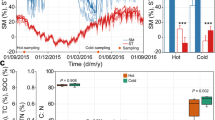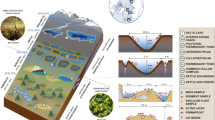Abstract
Hypolithic communities represent important reservoirs of microbial life in hyper-arid deserts. A number of studies on the diversity and ecology of these communities from different geographic areas have been reported in the past decade, but the spatial distribution of the different components of these communities is still not understood. Moss- and cyanobacteria-dominated hypolithic community morphotypes from Miers Valley (McMurdo Dry Valleys, East Antarctica) were analyzed by electron microscopy in order to characterize the microscale spatial structure. The two communities showed a high degree of internal organization, but differing according to the biological composition. In moss-dominated hypoliths, the moss plantlets are intermixed with mineral fragments of soil origin. However, in cyanobacteria-dominated hypoliths, a layered spatial organization was structured by filamentous cyanobacteria and associated extracellular polymeric components. While moss cells were lacking in cyanobacteria-dominated communities, biofilms formed by cyanobacteria and heterotrophic bacteria were observed in both community morphotypes. The water-holding capacity of both live and dead moss cells and the associated organic matrix, together with the protective properties of the extracellular polymeric substances, could facilitate the survival and activity of these communities. Similar structural strategies can favor the survival of microbial communities in different extreme environments.






Similar content being viewed by others
References
Azúa-Bustos C, González-Silva C, Mancilla R, Salas L, Gómez-Silva B, McKay C, Vicuña R (2011) Hypolithic cyanobacteria supported mainly by fog in the coastal range of the Atacama Desert. Microb Ecol 61:568–581
Barrett JE, Virginia RA, Parsons AN, Wall DH (2006) Soil carbon turnover in the McMurdo Dry Valleys, Antarctica. Soil Biol Biochem 38:3065–3082
Berner T, Evenari M (1978) The influence of temperature and light penetration on the abundance of the hypolithic algae in the Negev Desert of Israel. Oecologia 33:255–260
Billi D (2009) Subcellular integrities in Chroococcidiopsis sp. CCMEE 029 survivors after prolonged desiccation revealed by molecular probes and genome stability assays. Extremophiles 13:49–57
Broady PA (1981) The ecology of sublithic terrestrial algae at the Vestfold Hills, Antarctica. Br Phycol J 16:231–240
Cary SC, McDonald IR, Barrett JE, Cowan DA (2010) On the rocks: the microbiology of Antarctic Dry Valley soils. Nat Rev Microbiol 8:129–138
Chan Y, Lacap DC, Lau M, Ha K, Warren-Rhodes KA, Cockell CS, Cowan DA, McKay CP, Pointing S (2012) Hypolithic microbial communities: between a rock and a hard place. Environ Microbiol 14:2272–2282
Chan Y, Van Nostrandc JD, Zhou J, Pointing SB, Farrell RL (2013) Functional ecology of an Antarctic Dry Valley. Proc Natl Acad Sci USA 110:8990–8995
Chenu C (1993) Clay- or sand-polysaccharides associations as models for the interface between microorganisms and soil: water-related properties and microstructure. Geoderma 56:143–156
Cockell CS, Stokes MD (2004) Ecology widespread colonization by polar hypoliths. Nature 431:414
Cockell CS, Stokes MD (2006) Hypolithic colonization of opaque rocks in the Arctic and Antarctic polar desert. Arct Alp Res 38:335–342
Cowan DA, Ah Tow L (2004) Endangered Antarctic environments. Annu Rev Microbiol 58:649–690
Cowan DA, Khan N, Pointing SB, Cary C (2010) Diverse hypolithic refuge communities in the McMurdo Dry Valleys. Antarct Sci 22:714–720
Cowan DA, Sohm JA, Mackhalanyane TP, Capone D, Green TGA, Cary C, Tuffin IM (2011a) Hypolithic communities: important nitrogen sources in Antarctic desert soils. Environ Microbiol Rep 3:581–586
Cowan DA, Pointing SB, Stevens MI, Cary C, Stomeo F, Tuffin IM (2011b) Distribution and abiotic influences on hypolithic microbial communities in an Antarctic Dry Valley. Polar Biol 34:307–311
De los Ríos A, Ascaso C, Wierzchos J (1999) Study of lichens with different state of hydration by the combination of low temperature scanning electron and confocal laser scanning microscopies. Int Microbiol 2:251–257
De los Ríos A, Wierzchos J, Sancho LG, Ascaso C (2003) Acid microenvironments in microbial biofilms of Antarctic endolithic microecosystems. Environ Microbiol 5:231–237
De los Ríos A, Wiezchos J, Sancho LG, Ascaso C (2004) Exploring the physiological state of continental Antarctic endolithic microorganisms by microscopy. FEMS Microb Ecol 50:143–152
De los Ríos A, Wierzchos J, Sancho LG, Green A, Ascaso C (2005) Ecology of endolithic lichens colonizing granite in continental Antarctica. Lichenologist 37:383–395
De Los Ríos A, Grube M, Sancho LG, Ascaso C (2007) Ultrastructural and genetic characteristics of endolithic cyanobacterial biofilms colonizing Antarctic granite rocks. FEMS Microbiol Ecol 59:386–395
De los Ríos A, Raggio J, Pérez-Ortega S, Vivas M, Pintado A, Green TGA, Ascaso C, Sancho LG (2011) Anatomical, morphological and ecophysiological strategies in Placopsis pycnotheca (lichenized fungi, Ascomycota) allowing rapid colonization of recently deglaciated soils. Flora 206:857–864
De los Ríos A, Wierzchos J, Ascaso C (2014) The lithic microbial ecosystems of Antarctica’s McMurdo Dry Valleys. Antarct Sci. doi:10.1017/S0954102014000194
Decho AW, Kawaguchi T, Allison MA, Louchard EM, Reid P, Stephens FC, Voss KJ, Wheatcroft RA, Taylor BB (2003) Sediment properties influencing up-welling spectral reflectance signatures: the biofilm gel effect. Limnol Oceanogr 48:431–443
Dorioz JM, Robert M, Chenu C (1993) The role of roots, fungi and bacteria on clay particle organization. An experimental approach. Geoderma 56:179–194
Friedmann EI (1982) Endolithic microorganisms in the Antarctic cold desert. Science 215:1045–1053
Friedmann EI, Lipkin Y, Ocampo-Paus R (1967) Desert algae of the Negev (Israel). Phycologia 6:185–200
Golubic S, Friedmann EI, Schneider J (1981) The lithobiontic ecological niche, with special reference to microorganisms. J Sediment Petrol 51:475–478
Green TGA, Schroeter B, Sancho LG (1999) Plant Life in Antarctica. In: Pugnaire FI, Valladares F (eds) Plant life in Antarctica. Marcel Dekker Inc, New York, pp 495–543
Khan N, TuYn M, StaVord W, Cary C, Lacap D, Pointing S, Cowan D (2011) Hypolithic microbial communities of quartz rocks from Miers Valley, McMurdo Dry Valleys, Antarctica. Polar Biol 34:1657–1668
Konhauser K, Riding R (2012) Bacterial biomineralization. In: Knoll AH, Canfield DE, Konhauser KO (eds) Fundamentals of geobiology. Blackwell Publishing Ltd, Hoboken, pp 105–130
Krembs C, Eicken H, Junge K, Deming JW (2002) High concentrations of exopolymeric substances in Arctic winter sea ice: implications for the polar ocean carbon cycle and cryoprotection of diatoms. Oceanogr Res Pap 49:2163–2181
Lacap D, Warren-Rhodes K, McKay C, Pointing S (2011) Cyanobacteria and chloroflexi-dominated hypolithic colonization of quartz at the hyper-arid core of the Atacama Desert, Chile. Extremophiles 15:31–38
Makhalanyane TP, Valverde A, Birkeland NK, Cary C, Tuffin IA, Cowan DA (2013) Evidence for successional development in Antarctic hypolithic bacterial communities. ISME J 7:2080–2090
Nienow JA, Friedmann EI (1993) Terrestrial lithophytic (rock) communities. In: Friedmann EI (ed) Terrestrial lithophytic (rock) communities. Wiley-Liss, New York, pp 343–412
Pointing SB, Belnap J (2012) Microbial colonization and controls in dryland systems. Nat Rev 10:551–562
Pointing SB, Warren-Rhodes KA, Lacap DC, Rhodes KL, McKay CP (2007) Hypolithic community shifts occur as a result of liquid water availability along environmental gradients in China’s hot and cold hyperarid deserts. Environ Microbiol 9:414–424
Pointing SB, Chan Y, Lacap DC, Lau MCY, Jurgens JA, Farrell RL (2009) Highly specialized microbial diversity in hyper-arid polar desert. Proc Natl Acad Sci 106:19964–19969
Schlesinger W, Pippen J, Wallenstein M, Hofmockel K, Klepeis D, Mahall B (2003) Community composition and photosynthesis by photoautotrophs under quartz stones, southern Mojave Desert. Ecology 84:3222–3231
Siebert J, Hirsch P (1988) Characterization of 15 selected coccal bacteria isolated from Antarctic rock and soil samples from the McMurdo-Dry Valleys (South-Victoria Land). Pol Biol 9:37–44
Smith HD, Baqué M, Duncan AG, Lloyd CR, McKay CP, Billi D (2014) Comparative analysis of cyanobacteria inhabiting rocks with different light transmittance in the Mojave Desert: a Mars terrestrial analogue. Int J Astrobiol 13:271–277
Stomeo F, Valverde A, Pointing S, McKay C, Warren-Rhodes K, Tuffin MI, Seely M, Cowan DA (2013) Hypolithic and soil microbial community assembly along an aridity gradient in the Namib Desert. Extremophiles 17:329–337
Tracy C, Streten-Joyce C, Dalton R, Nussear K, Gibb K, Christian K (2010) Microclimate and limits to photosynthesis in a diverse community of hypolithic cyanobacteria in northern Australia. Environ Microbiol 12:592–607
Warren-Rhodes KA, Rhodes KL, Pointing SB, Ewing SA, Lacap DC, Gómez-Silva B, Amundson R, Friedmann EI, McKay CP (2006) Hypolithic cyanobacteria, dry limit of photosynthesis, and microbial ecology in the hyperarid Atacama Desert. Microb Ecol 52:389–398
Weber B, Wessels D, Deutschewitz K, Dojani S, Reichenberger H, Büdel B (2013) Ecological characterization of soil-inhabiting and hypolithic soil crusts within the Knersvlakte, South Africa. Ecol Process 2:8
Wierzchos J, Ascaso C (1994) Application of back-scattered electron imaging to the study of the lichen rock interface. J Microsc 175:54–59
Wierzchos J, de los Ríos A, Ascaso C (2012) Microorganisms in desert rocks: the edge of life on Earth. Int Microbiol 15:171–181
Wong F, Lau M, Lacap D, Aitchison J, Cowan DA, Pointing SB (2010) Endolithic microbial colonization of limestone in a high-altitude arid environment. Microb Ecol 59:689–699
Acknowledgments
We are grateful to Antarctica New Zealand (AntNZ) for logistical support. The New Zealand Foundation for Research, Science and Technology (FRST), the University of Waikato Vice Chancellor’s Fund, and the Department of Biological Sciences, University of Waikato provided financial support to SCC. DAC acknowledges financial support from the South African NRF SANAP program and the UP Genomics Research Institute. The microscopy study was funded by the Spanish Education Ministry grant CTM2012-38222-C02-02. The authors would like to thank to the ICA and the MNCN microscopy services staff for technical assistance and Glen Stichbury (University of Waikato) for elaborating the maps.
Author information
Authors and Affiliations
Corresponding author
Rights and permissions
About this article
Cite this article
de los Ríos, A., Cary, C. & Cowan, D. The spatial structures of hypolithic communities in the Dry Valleys of East Antarctica. Polar Biol 37, 1823–1833 (2014). https://doi.org/10.1007/s00300-014-1564-0
Received:
Revised:
Accepted:
Published:
Issue Date:
DOI: https://doi.org/10.1007/s00300-014-1564-0




